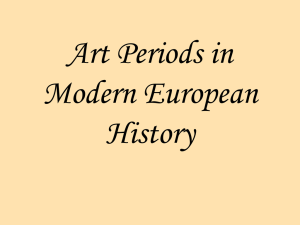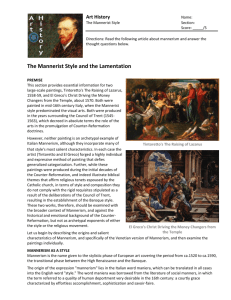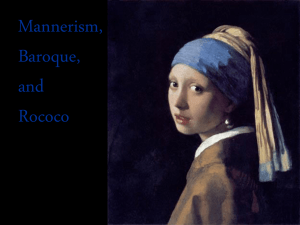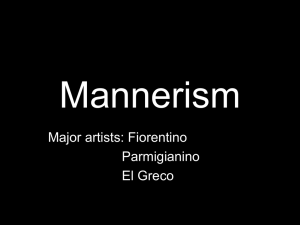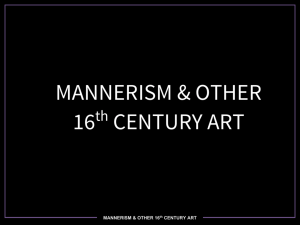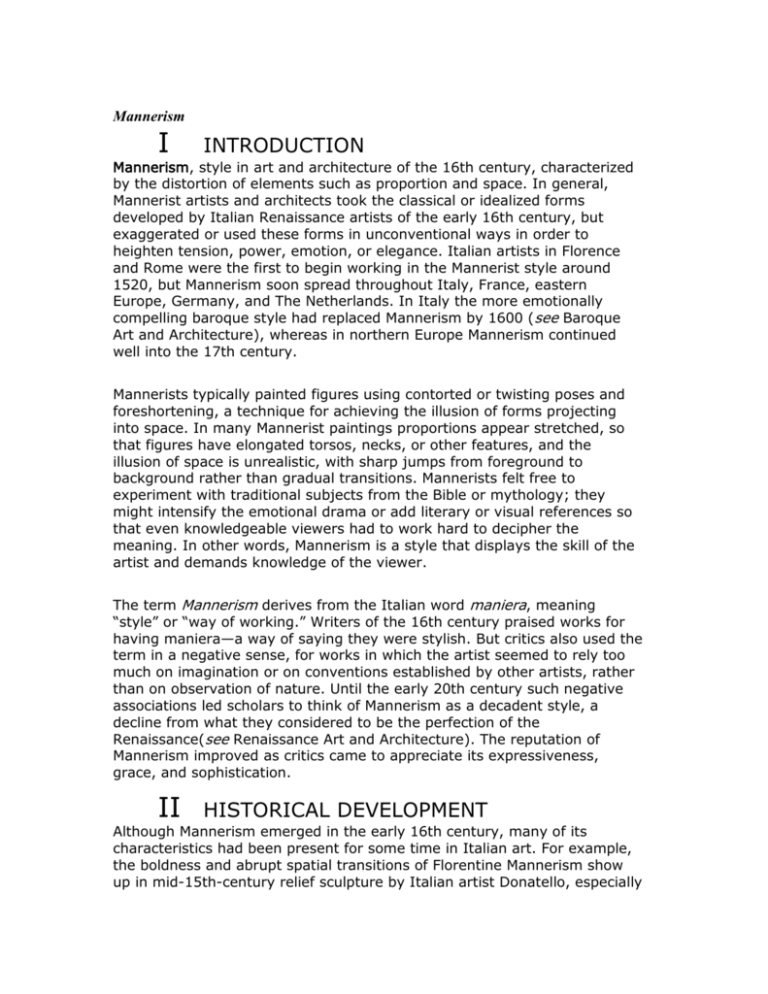
Mannerism
I
INTRODUCTION
Mannerism, style in art and architecture of the 16th century, characterized
by the distortion of elements such as proportion and space. In general,
Mannerist artists and architects took the classical or idealized forms
developed by Italian Renaissance artists of the early 16th century, but
exaggerated or used these forms in unconventional ways in order to
heighten tension, power, emotion, or elegance. Italian artists in Florence
and Rome were the first to begin working in the Mannerist style around
1520, but Mannerism soon spread throughout Italy, France, eastern
Europe, Germany, and The Netherlands. In Italy the more emotionally
compelling baroque style had replaced Mannerism by 1600 (see Baroque
Art and Architecture), whereas in northern Europe Mannerism continued
well into the 17th century.
Mannerists typically painted figures using contorted or twisting poses and
foreshortening, a technique for achieving the illusion of forms projecting
into space. In many Mannerist paintings proportions appear stretched, so
that figures have elongated torsos, necks, or other features, and the
illusion of space is unrealistic, with sharp jumps from foreground to
background rather than gradual transitions. Mannerists felt free to
experiment with traditional subjects from the Bible or mythology; they
might intensify the emotional drama or add literary or visual references so
that even knowledgeable viewers had to work hard to decipher the
meaning. In other words, Mannerism is a style that displays the skill of the
artist and demands knowledge of the viewer.
The term Mannerism derives from the Italian word maniera, meaning
“style” or “way of working.” Writers of the 16th century praised works for
having maniera—a way of saying they were stylish. But critics also used the
term in a negative sense, for works in which the artist seemed to rely too
much on imagination or on conventions established by other artists, rather
than on observation of nature. Until the early 20th century such negative
associations led scholars to think of Mannerism as a decadent style, a
decline from what they considered to be the perfection of the
Renaissance(see Renaissance Art and Architecture). The reputation of
Mannerism improved as critics came to appreciate its expressiveness,
grace, and sophistication.
II
HISTORICAL DEVELOPMENT
Although Mannerism emerged in the early 16th century, many of its
characteristics had been present for some time in Italian art. For example,
the boldness and abrupt spatial transitions of Florentine Mannerism show
up in mid-15th-century relief sculpture by Italian artist Donatello, especially
the carved pulpits he created for the Church of San Lorenzo (1465-1466,
Florence, Italy) during the final years of his life. Foreshortening was a
common practice in painting in the 15th and early 16th centuries. Italian
Renaissance artist Michelangelo used foreshortening as a visual means to
give power and movement to key figures in his ceiling paintings in the
Sistine Chapel (1508-1512, Vatican Palace, Rome). Michelangelo himself
worked in the Mannerist style in his later works, such as the Last Judgment
(1536-1541, Sistine Chapel, Vatican City). In this painting he used
foreshortening with less restraint but with the same intent—to make the
composition visually powerful and to exhibit his skill.
III
EARLY MANNERISM IN FLORENCE
The first phase of Mannerism had its center in Florence and was led by
Italian painters Jacopo da Pontormo and Rosso Fiorentino. Florentine
Mannerism is imaginative and expressive, characterized by restless
movement, brilliant and sometimes clashing colors, elongated proportions,
and irrational spaces. The Florentine Mannerists were influenced by
Michelangelo's designs for the Medici Chapel (1519-1534, Church of San
Lorenzo, Florence), in which elegant figures in unnaturally twisted poses
are set within a complex architectural framework and laden with meaning.
Pontormo was a reclusive person, and many of his works have an
otherworldly quality that heightens their spiritual intensity. This quality is
seen in his Deposition (1525-1528, Church of Santa Felicitá, Florence), an
altarpiece painted with luminous tints of pink, orange, blue-violet, and
green. The lack of dark shadows in this painting, as well as the sense that
the figures are weightlessly suspended in space, adds to the work’s strange
beauty. The painting shows the body of Christ being taken from his mother
Mary’s arms after the crucifixion; a figure standing to the right of the bluerobed Mary is Pontormo himself.
Rosso, like Pontormo, elongated his figures and exaggerated their facial
expressions, but he used bolder brushstrokes and sometimes modeled the
figures so that they appear sharp and angular. In his masterpiece, Descent
from the Cross (1521, Pinacoteca Comunale, Volterra, Italy), Rosso treats a
traditional religious theme in a nontraditional manner. Unlike Renaissance
compositions of just a few years earlier, Rosso’s composition appears to
move outward from the center of the canvas, to the tangle of figures that
ring the cross at the center. The composition spreads across the surface of
the painting with little suggestion of deep space.
IV
ROMAN MANNERISM
Roman Mannerism shows the same love of complex compositions and
references that Florentine Mannerism does, but the Roman version
generally employs forms that are more classical, colors that are more
harmonious, and figures that are more three-dimensional. Roman
Mannerism is directly descended from the late style of Renaissance painter
Raphael, especially his last altarpiece, the Transfiguration (1517-1520,
Vatican Pinacoteca, Rome), and his last series of murals for the Vatican
Palace (1514-1517). Many of the leading Mannerists in Rome, such as
Giulio Romano and Perino del Vaga, studied and worked in Raphael's
workshop and completed his projects after he died in 1520. However,
influences on Roman Mannerism also came from outside the city, because
commissions for art to decorate churches in Rome drew artists from all
over. After Rome was sacked in 1527 by the armies of Holy Roman
Emperor Charles V, artists sought employment elsewhere and thus helped
spread Roman Mannerism in Italy and to other countries.
Giulio Romano inherited not only many of Raphael's fresco projects, but
also Raphael's lively interest in architecture. In 1524 Giulio went to Mantua,
where he designed the Palazzo del Tè (1525?-1534). He showed great
inventiveness in the design of this palace, creating architecture and
paintings that would challenge and delight by their playful departures from
classical tradition. He employed accepted classical forms—walls with
pilasters (half-columns) that supported horizontal entablatures (bands of
decoration), and pediments (triangular elements) over windows and doors.
But rather than achieving the balanced effect expected in classical
architecture, Giulio varied these forms and the rhythms created by their
repetition, so that each sequence of elements is similar and yet slightly
different from the others. One detail illustrates the wit in many Mannerist
works: Keystones at the top of each arched window are oversized and seem
to slip down, as if about to fall.
Giulio also was responsible for the paintings in many rooms of the palace,
most notably in the Sala dei Giganti (Room of the Giants). His frescoes
(paintings on wet plaster) on the ceiling and walls merge to create a violent
battle scene between the Greek gods of Mount Olympus and the giants they
defeated, in which a temple seems to collapse into the room itself. This is
an excellent example of how Mannerist artists used perspective to create
illusions that would both shock and amuse viewers.
Francesco Mazzola, better known as Parmigianino, was born in Parma, and
trained under Renaissance painter Correggio. Parmigianino brought his
graceful and elegant style to Rome in 1524, but he worked there only three
years before the sack of the city caused him to flee back to Parma. His
Madonna with the Long Neck (1534-1540, Uffizi, Florence) shows a
sensuous Virgin Mary, whose elongated body and languid gestures reflect
ideals of feminine beauty from that time. However, the painting shows
glaring inconsistencies in its depiction of space: Mary, Jesus, and their
attendant angels loom in the foreground, dwarfing a tiny prophet figure at
lower right, and a single column in the background starts as multiple
columns at its base.
V
LATER MANNERISM
In Florence, a second generation of Mannerists moved away from the
expressive style of Pontormo and Rosso and developed a more elegant
style. Regional differences in Mannerism seem to fade after about 1530,
because the artists often moved around, many working for the courts of the
nobility, who encouraged similarly stylish works. Italian sculptor and
goldsmith Benvenuto Cellini was trained in Florence but moved often
between that city and Rome. He also spent many years in northwestern
France, where King Francis I had appointed him, Rosso Fiorentino,
Francesco Primaticcio, and other Italian Mannerists to complete elaborate
decorations for the Palace of Fontainebleau (see School of Fontainebleau).
Cellini’s exquisite gold Salt Cellar of Francis I (1540-1543,
Kunsthistorisches Museum, Vienna, Austria) shows two figures: Neptune,
representing the sea (the origin of salt), and the female figure of Earth (the
origin of pepper). Earth is seated on a cushion shaped like an elephant's
head (a symbol for the East) to remind the viewer where pepper comes
from. The wealth of ornament, symbolism, and materials makes this
supposedly practical object a masterpiece of Mannerist sculpture. In his
large-scale sculpture Perseus and Medusa (1545-1554, Loggia dei Lanzi,
Florence), Cellini has balanced the larger forms and gestures of Perseus
with areas of finely wrought detail.
Florentine Agnolo Bronzino, a student of Pontormo, first worked in a
similarly expressive style. But Bronzino is better known for his later, more
coolly polished style, as seen in his St. John the Baptist (mid-16th century,
Borghese Gallery, Rome). The figure of Saint John appears in a serpentine
pose—his torso twisted so that one leg comes sharply forward along with
the opposite shoulder. Mannerists considered this particular pose most
beautiful because of the liveliness of its spiraling movement.
Bronzino’s painting is also notable because it portrays a saint nearly nude.
The artist may have been following the example of Michelangelo's Last
Judgment, in which both saints and sinners are shown completely nude
(loincloths were added later in the 16th century). The Last Judgment shows
not only extensive nudity (Michelangelo felt the nude human body was
God's greatest creation), but also complex movement and references to
classical mythology and works of literature such as the Inferno (1321?) by
Dante Alighieri. By the mid-16th century, many critics in the popular press
had made the point that the Last Judgment, and by extension all Mannerist
art, was inappropriate for teaching people about religion, because the
artists seemed to care more about showing off their skills than about
communicating ideas effectively. By about 1580 artists began to develop a
simpler, more emotionally compelling style in response to these criticisms,
and this development eventually led to the baroque style.
Contributed By:
Bernadine Barnes
1
1"Mannerism."Microsoft® Encarta® Encyclopedia 2001. © 1993-2000 Microsoft
Corporation. All rights reserved.

